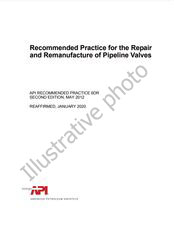We need your consent to use the individual data so that you can see information about your interests, among other things. Click "OK" to give your consent.

The information about the standard:
Designation standards: API PUBL 4580-ed.1993
Publication date standards: 1.1.1993
SKU: NS-1139763
The number of pages: 855
Approximate weight : 2596 g (5.72 lbs)
Country: American technical standard
Category: Technical standards API
Annotation of standard text API PUBL 4580-ed.1993 :
API PUBL 4580, 1993 Edition, 1993 - 1993 Oil Spill Conference
Scope of the manual
The (draft) manual contains guidelines for the selection of oil spill protection and cleanup techniques. The selection process focuses on the identification of techniques that themselves would have minimal intrinsic ecological impacts and that also would minimize the ecological impacts of the oil in inland waters. A secondary aspect of the manual is to provide this direction while recognizing potential human health risks of the spill and response methods. The manual can be used as an aid in contingency planning or as an aid to field response, when consensus decisions must be reached rapidly.
The manual is intended to present the ecologically preferred response options for a variety of freshwater habitats, oil types, and spill conditions. Seven habitats were identified in the original workshop discussions. In turn, these were subdivided during work sessions, which resulted in a total of ten primary habitats for the manual.
• large rivers
• small rivers and streams
• Great Lakes
open water
nearshore
• inland lakes and ponds
• marsh/wetlands
• rock shorelines or man-made structures
• gravel shorelines (coarse-grained beaches/river bars)
• sand shorelines
• mud shorelines
Note that the Great Lakes are considered in terms of open water and nearshore habitats.
Response techniques are described for protection, cleanup, and treatment methods. Each technique was evaluated as a counter-measure for four oil types: gasoline, diesel/No. 2 fuel oil, medium grade crude, and bunker C/No. 6 fuel oil. Furthermore, each technique was evaluated for three degrees of impact from each oil type: low, moderate, and high oiling.
Specifically, the manual provides a description of protection and cleanup techniques, summary tables that indicate the intrinsic impact of a particular technique on habitats in the absence of oil, decision trees for protection and cleanup, and protection and cleanup summary matrices for habitats and for four oil types.
Sections for each habitat contain a description of the habitat, a relative sensitivity ranking, and a matrix of response options in terms of impact on the habitat and recommendation for use of each method for each of the four oil types.
We recommend:
Technical standards updating
Do you want to make sure you use only the valid technical standards?
We can offer you a solution which will provide you a monthly overview concerning the updating of standards which you use.
Would you like to know more? Look at this page.



 Cookies
Cookies
